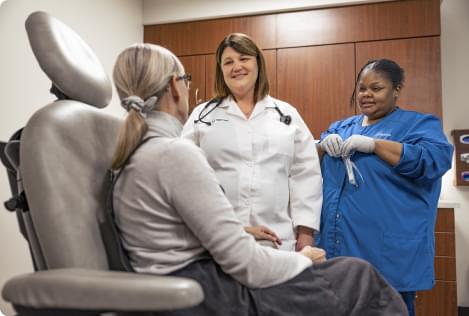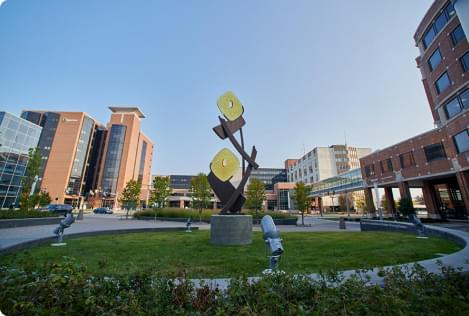Overview
Diffuse midline glioma (DMG) is a rare type of cancerous brain tumor. It's most common in children between the ages of 5 and 10 years old, though it can also affect adults. The name means:
- Diffuse: The cancer cells have spread beyond the tumor and into healthy brain tissue.
- Midline: The tumor is found in the middle section of the central nervous system, usually the thalamus, spinal cord or brainstem, also called the pons.
- Glioma: The tumor grew from glial cells, which are "helper" cells in the white matter of the brain.
The term "diffuse intrinsic pontine glioma" (DIPG) used to be used for tumors in the pons area of the brain. Now the term DMG is used to describe these tumors instead of the older term, DIPG. DIPG also may be called H3K27-altered DMG.
The name DIPG means:
- Diffuse: The cancer cells have spread beyond the tumor into healthy brain tissue.
- Intrinsic: The tumor grew from inside the brain tissue.
- Pontine: The tumor is found in the pons, the area of the brainstem that helps control things such as breathing and heartbeats.
- Glioma: The tumor grew from glial cells, which are helper cells found in the white matter of the brain.
DMG is an aggressive type of cancer. Symptoms of DMG usually start suddenly and quickly get worse. DMG may be diagnosed with a review of symptoms, a brain MRI and other tests. There is no cure for DMG. The most common treatments are radiation therapy and chemotherapy. These treatments aim to ease discomfort and help extend life, but they do not cure the cancer.
Symptoms
Symptoms of diffuse pontine glioma (DMG) depend on where in the central nervous system the tumor is growing. Symptoms at first may be mild and easy to overlook. But they get worse over a few weeks or months. It's very difficult to diagnose DMG in the early stages.
Common symptoms of DMG include:
- Drooping on one side of the face.
- Weakness in the facial muscles.
- Weakness in the arms and legs, particularly on one side.
- Clumsiness.
- Fatigue.
- Headaches, particularly in the morning.
- Nausea and vomiting.
- Problems with speech or swallowing.
- Balance problems.
- Difficulty walking.
- Tingling or numbness, which may affect the face, arms, hands or legs.
- Difficulty concentrating.
- Seizures.
- Back pain.
- Changes in bladder and bowel function.
- Vision problems, including blurry or double vision.
- Hearing problems, including loss of hearing.
- Behavior changes, such as irritability or trouble at school.
- Gaining weight.
When to seek care
Make an appointment with a doctor or other healthcare professional if you have any symptoms that worry you.
Causes
The cause of diffuse midline glioma (DMG) isn't completely understood. It's thought to be caused by a gene change that is not expected, such as a random mistake. Genes provide a set of instructions for every cell that tell it how to grow and function. Gene changes, also called mutations, happen when there is an error in these instructions.
The mutations that cause DMG affect the H3K27-altered gene, which is a histone gene. Histone genes help package DNA in cells and manage which genes are turned off or on. When histone genes change, cells cannot regulate themselves properly and don't stop growing when they should. This allows the cells to multiply very quickly and form a tumor.
Another cause of DMG is a change, also called disruption, in the healthy growth of glial cells. Glial cells are part of the white matter of the brain. They support healthy cell development and function. Also caused by the histone gene mutation, this disruption causes the glial cells to grow out of control.
It's possible that DMG may be related to the rapid brain growth of children between the ages of 5 and 10, since this is the most common age for people to be diagnosed with DMG. This time period where the brain grows rapidly may make the brain at risk for these changes in genes.
Risk factors
There are no known risk factors for diffuse midline glioma and no known way to prevent these tumors.
Diagnosis
Diffuse midline glioma (DMG) is usually diagnosed through a combination of methods. Your healthcare professional usually starts by reviewing your symptoms, giving you a physical exam and taking your medical history.
The main tool used to diagnose DMG is MRI. This imaging test can find these types of tumors based on their location and features, such as borders that are not well defined. Usually, dye isn't needed as part of the MRI.
If MRI cannot tell the difference between DMG and other gliomas, a biopsy may be done. A biopsy is a procedure that removes a small sample of tumor tissue for study under a microscope in a lab. This exam can diagnose DMG by testing for the H3K27-altered gene mutation in the tumor sample.
Treatment
Diffuse midline glioma (DMG), is a very aggressive brain tumor that spreads very quickly. There isn't a cure for DMG, but treatments can help manage symptoms so that people with DMG can live longer and more comfortably.
Radiation therapy
The most common treatment for DMG is radiation therapy. Radiation therapy uses precise, highly concentrated beams of energy to destroy the tumor cells. This treatment usually is given in multiple sessions over about six weeks. It can slow down the growth of the tumor and help reduce some of the symptoms it causes.
Unfortunately, DMG tumors often grow back after radiation therapy.
Surgery
Usually, surgery isn't an option for these types of tumors because of where they grow in the brain. They grow in the midline, where essential parts of the brain are found. For this reason, surgery can be too risky. Also, the poorly defined edges of the tumor make it difficult to remove with surgery.
Medicines
Chemotherapy, which is medicine designed to kill cancer cells, usually isn't effective for DMG. But sometimes, chemotherapy may be used along with radiation therapy.
Palliative treatment
Palliative treatment does not aim to cure cancer but to make life better and manage symptoms such as difficulty swallowing, pain, headaches, and difficulty walking and moving around. Palliative treatment for DMG can include:
- Steroid medicines to reduce swelling in the brain.
- Support for feeding and nutrition.
- Speech therapy.
- Occupational therapy.
- Physical therapy.
- Medicines to prevent seizures.
- Pain medicine.
- Procedures to drain fluid buildup on the brain.
- Counseling and other therapy to help cope with DMG.
Potential future treatments
Researchers are studying new medicines to treat diffuse midline glioma and new ways of delivering them. Research includes new chemotherapy medicines that target the changed genes in DMG tumors.
Clinical trials are studying medicines that target these cancer cells specifically and deliver them directly to the tumor via a catheter and other novel methods.
Clinical trials also are looking at immunotherapy treatments for DMG. Immunotherapy medicines help the body's immune system find and destroy cancer cells. These medicines include immune checkpoint inhibitors, monoclonal antibodies and vaccines. All of these treatments target cancer cells through the immune system.
Current clinical trials are investigating the use of chimeric antigen receptor (CAR)-T cell therapy. In this treatment, white blood cells called T cells are removed from the blood. In a lab, scientists change these T cells and add a receptor called a CAR. The CAR allows the T cells to track and find cancer cells more easily.
Scientists then grow and multiply the CAR-T cells in a lab, producing millions of very powerful cells. These CAR-T cells are put back into the blood through a needle placed in a vein in the arm, also called an IV. CAR T-cells can keep living and working in the body for a long time, so they're sometimes called a "living drug."
Prognosis
Every person with DMG and every diagnosis is different. DMG is usually fatal. Life expectancy is usually between 9 and 12 months after diagnosis. Most people survive less than a year after diagnosis. Some people live longer with DMG. This depends on several factors, including how well they respond to treatment and the tumor grade at diagnosis. Clinical trials can help people with DMG live longer.
A healthcare team can provide support and guidance for end-of-life care.
Coping and support
Learning that you have a diffuse midline glioma can be overwhelming and frightening. But you can take steps to cope after your diagnosis.
Find out all you can about diffuse midline glioma
Write down your questions and bring them to your appointments. As your healthcare professional answers your questions, take notes. Or ask a friend or family member to come along to take notes.
The more you and your family know and understand about your care, the more confident you'll feel when it's time to make treatment decisions.
Get support
Find someone you can share your feelings and concerns with. You may have a close friend or family member who is a good listener. Or speak with a clergy member or counselor.
You may find it helpful to talk with other people who have diffuse midline glioma. Ask your healthcare team about support groups for people with DMG. These support groups may be available online and in your area.
Take care of yourself
Check with your healthcare professional to see if it's safe for you to exercise. Get enough sleep so that you feel rested.
Reduce stress in your life by taking time for relaxing activities, such as listening to music or writing in a journal.
Preparing for an appointment
If you have symptoms that worry you, make an appointment with a doctor or other healthcare professional. If you have DMG, you'll likely be referred to specialists, such as:
- Doctors who specialize in brain disorders, called neurologists.
- Doctors who treat cancer with medicine, called medical oncologists.
- Doctors who use radiation to treat cancer, called radiation oncologists.
- Doctors who specialize in nervous system cancers, called neuro-oncologists.
- Surgeons who operate on the brain and nervous system, called neurosurgeons.
- Rehabilitation specialists.
Here's some information to help you get ready for your appointment.
What you can do
- Be aware of anything you need to do before your appointment. At the time you make the appointment, be sure to ask if there's anything you need to do in advance, such as change your diet.
- Write down any symptoms you've been experiencing and how long you've had them.
- List your key medical information, including all conditions you have and the names of any medicines you're taking. Include prescription medicines and medicines you can buy without a prescription.
- Take a family member or friend with you. Sometimes it can be difficult to remember all of the information you get during an appointment. Someone who goes with you may remember something that you missed or forgot.
- Write down questions to ask your healthcare professional.
Questions to ask at your first appointment include:
- What may be causing my symptoms?
- Are there any other possible causes?
- What kinds of tests do I need? Do these tests require any special preparation?
- What do you recommend for the next steps in determining my diagnosis and treatment?
- Should I see a specialist?
Questions to ask an oncologist or a neurologist include:
- Do I have DMG?
- How will the DMG grow over time?
- Where is the DMG located?
- How large is the DMG?
- What might happen because of the DMG?
- What are the goals of my treatment?
- Is surgery a treatment option? What are the risks?
- Is radiation therapy a treatment option? What are the risks?
- Will I need chemotherapy?
- What treatment approach do you recommend?
- If the first treatment doesn't work, what will we try next?
- What is the prognosis for my condition?
- Do I need a second opinion?
- Is there a clinical trial available for people with DMG? Is it right for me?
In addition to the questions that you've prepared, don't hesitate to ask any other questions that may come up during your appointment.
What to expect from your doctor
Be prepared to answer questions about your symptoms and your health history. Questions may include:
- What are your symptoms?
- When did you first notice these symptoms?
- Have your symptoms gotten worse over time?
- If you have pain, where does the pain seem to start?
- Does the pain spread to other parts of your body?
- Have you participated in any activities that might explain the pain, such as a new exercise or a long stretch of gardening?
- Have you experienced any weakness or numbness in your legs?
- Have you had any difficulty walking?
- Have you had any changes in your bladder or bowel function?
- Have you been diagnosed with any other medical conditions?
- Are you currently taking any medicines, including prescription medicines and medicines that you can get without a prescription?
- Do you have any family history of noncancerous or cancerous tumors?
© 1998-2025 Mayo Foundation for Medical Education and Research (MFMER). All rights reserved. Terms of Use


